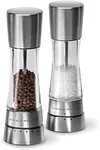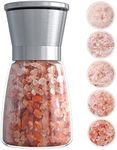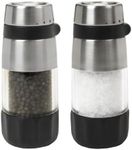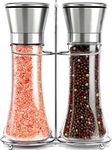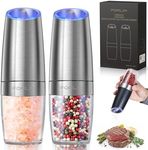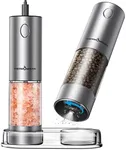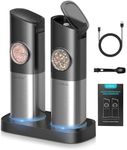Buying Guide for the Best Salt And Pepper Mills
Choosing the right salt and pepper mills can enhance your cooking experience and add a touch of elegance to your kitchen or dining table. When selecting the best mills for your needs, consider factors such as the type of mechanism, material, size, and ease of use. Understanding these key specifications will help you make an informed decision and ensure that your mills meet your culinary requirements.Grinding MechanismThe grinding mechanism is the part of the mill that crushes the salt or pepper. This spec is important because it determines the consistency and efficiency of the grind. Common materials for grinding mechanisms include stainless steel, ceramic, and carbon steel. Stainless steel is durable and resistant to corrosion, making it ideal for pepper. Ceramic is also durable and can handle both salt and pepper without corroding. Carbon steel is very sharp and efficient for pepper but can corrode with salt. Choose a mechanism based on the type of seasoning you use most frequently and the durability you need.
MaterialThe material of the mill's body affects its durability, appearance, and ease of cleaning. Common materials include wood, stainless steel, acrylic, and plastic. Wooden mills offer a classic look and are sturdy but may require more maintenance. Stainless steel mills are sleek, modern, and easy to clean. Acrylic mills allow you to see the contents and monitor the level of salt or pepper but can be prone to scratching. Plastic mills are lightweight and affordable but may not be as durable. Choose a material that matches your kitchen decor and meets your durability and maintenance preferences.
SizeThe size of the mill affects how much salt or pepper it can hold and how often you need to refill it. Smaller mills are more compact and easier to handle but require frequent refilling. Larger mills hold more seasoning, reducing the need for refills, but can be bulkier and harder to store. Consider how often you use salt and pepper and how much space you have in your kitchen or dining area. If you cook frequently and use a lot of seasoning, a larger mill may be more convenient. For occasional use or limited space, a smaller mill might be a better fit.
AdjustabilityAdjustability refers to the ability to change the coarseness of the grind. This spec is important because different recipes and personal preferences may require different grind sizes. Some mills offer a simple knob or dial to adjust the grind from fine to coarse. Others may have preset settings for specific grind sizes. If you enjoy experimenting with different textures in your cooking, look for a mill with easy and precise adjustability. If you prefer a consistent grind, a mill with preset settings might be more suitable.
Ease of UseEase of use encompasses how comfortable and convenient the mill is to operate. This includes factors like the grip, weight, and how easy it is to refill. A mill with an ergonomic design and a comfortable grip will be easier to use, especially for extended periods. The weight should be balanced – not too heavy to handle but sturdy enough to provide stability. Refilling should be straightforward, with a wide opening to prevent spills. Consider your own comfort and how often you will be using the mill to determine the best ease-of-use features for you.

